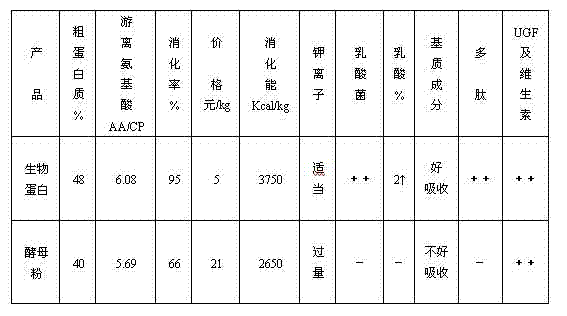Biological protein feed and preparation technology thereof
A technology of protein feed and preparation process, which is applied in the field of feed, can solve the problems of fast drying speed, violation, and destruction of nutritional components, and achieve the effects of improving absorption and utilization, reducing breeding costs, and reducing secondary pollution
- Summary
- Abstract
- Description
- Claims
- Application Information
AI Technical Summary
Problems solved by technology
Method used
Image
Examples
Embodiment 1
[0014] Mix ingredients according to 1000Kg of soybean meal, 50Kg of corn flour, 8Kg of glucose, 6Kg of strain, and 450Kg of water.
[0015] After the materials are mixed evenly by the mixer, they are put into the fermentation tank. The top of the tank is completely closed. The floor heating (water heating) system on the bottom and wall of the tank is used to heat and start the fermentation. The temperature was maintained between 35°C-42°C for 72 hours. After that, the material is transferred from the fermentation tank to the aerobic fermentation workshop. The thickness of the material is about 30 cm. The radiator is used to maintain the room temperature at about 28°C-37°C, and the fermentation is carried out for 24 hours, during which the material is turned once. After the fermentation is over, the material is transferred to the drying workshop, where it is dried with an airflow dryer until the moisture content is less than 12.5%, then crushed, packed and weighed, and the fini...
Embodiment 2
[0017] 800Kg of soybean meal, 60Kg of corn flour, 5Kg of glucose, 4Kg of bacterial strain (purchased from XXX company), and 500Kg of water are used for mixing ingredients.
[0018] After the materials are mixed evenly by the mixer, they are put into the fermentation tank. The top of the tank is completely closed. The floor heating (water heating) system on the bottom and wall of the tank is used to heat and start the fermentation. The temperature was maintained between 35°C-42°C for 70 hours. After that, the material is transferred from the fermentation tank to the aerobic fermentation workshop. The thickness of the material is about 30 cm. The radiator is used to maintain the room temperature at about 28°C-37°C, and the fermentation is carried out for 22 hours, during which the material is turned once. After the fermentation is over, the material is transferred to the drying workshop, where it is dried with an airflow dryer until the moisture content is less than 12.5%, then ...
Embodiment 3
[0020] 1200Kg of soybean meal, 40Kg of corn flour, 10Kg of glucose, 8Kg of bacterial strain (purchased from XXX company), and 400Kg of water are used for mixing ingredients.
[0021] After the materials are mixed evenly by the mixer, they are put into the fermentation tank. The top of the tank is completely closed. The floor heating (water heating) system on the bottom and wall of the tank is used to heat and start the fermentation. The temperature was maintained between 35°C-42°C for 76 hours. After that, the material is transferred from the fermentation tank to the aerobic fermentation workshop. The thickness of the material is about 30 cm. The radiator is used to maintain the room temperature at about 28°C-37°C, and the fermentation is carried out for 26 hours, during which the material is turned once. After the fermentation is over, the material is transferred to the drying workshop, where it is dried with an airflow dryer until the moisture content is less than 12.5%, the...
PUM
 Login to View More
Login to View More Abstract
Description
Claims
Application Information
 Login to View More
Login to View More - R&D
- Intellectual Property
- Life Sciences
- Materials
- Tech Scout
- Unparalleled Data Quality
- Higher Quality Content
- 60% Fewer Hallucinations
Browse by: Latest US Patents, China's latest patents, Technical Efficacy Thesaurus, Application Domain, Technology Topic, Popular Technical Reports.
© 2025 PatSnap. All rights reserved.Legal|Privacy policy|Modern Slavery Act Transparency Statement|Sitemap|About US| Contact US: help@patsnap.com

